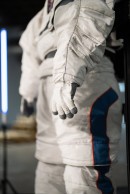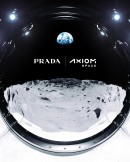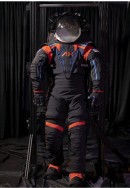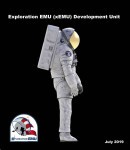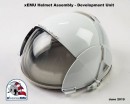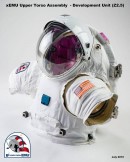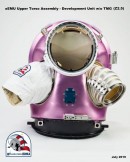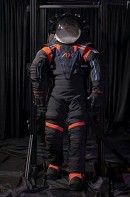Space suits are serious business. Their only purpose is insulating us sweaty and vulnerable meat sacks from the brutal and utterly inhospitable environments beyond Earth's atmosphere. With NASA's Artemis program set to deliver humans back to the Moon for the first time in generations this decade, the scramble to ensure a suitable space suit is ready in time is well and truly on. So, who do you think got the call to help make this new design a reality?
Well, if you read the title, you already know the answer. But, to humor you, if your first guess was the historic Italian luxury fashion designers at Prada, well, we're not sure why you'd come to this conclusion. But somehow, in this post-modernist world that we live in where nothing makes sense, that's precisely the collaboration that's on the table. Well, it's more complicated, of course. But seeing the name of the pound-for-pound biggest name in Italian luxury fashion tied to something not even remotely posh or luxurious has us perplexed and eager to learn how such strange cooperation came to be. And no, it's not just for eye candy reasons like Prada's handbags.
In truth, what's easy to misidentify as a direct partnership between Prada and NASA is a three-party affair that also involves the Houston, Texas-based aerospace manufacturer Axiom Space. Headed by Michael T. Suffredini, the former program manager for the International Space Station, Axiom, and Prada will work in tandem to present NASA with a space suit capable of adapting to the unprecedented environments the Artemis III mission is expected to encounter when it delivers the first woman and the first person of color to the Lunar surface in 2025. But to understand the scale of the work that lies ahead for Prada and Axiom, we need to look back at what Moon-fairing spacesuits used to be like during the Apollo program.
During this time, what was called the Extravehicular Mobility Unit (EMU), or the Apollo lunar spacesuit (A-7L), was as much of a marvel of late 60s engineering as the Lunar Module or the Saturn V rocket themselves. According to the Smithsonian National Air and Space Museum, the suit consisted of 25 layers of protective material derived from what were, at the time, relatively new textiles and fabrics like Teflon, nylon, mylar, lycra spandex, and a fiberglass-like material that wouldn't irritate human skin called beta silica fiber. Many of these materials came courtesy of the DuPont Chemical company, but like the tentative spacesuit design for the Artemis program, the Apollo EMU was a nationwide undertaking involving several different aerospace contractors dedicated to each piece of its construction.
The A-7L weighed roughly 81 lbs on Earth with its primary life support system (PLSS) installed, or around 30 lbs when compensating for lunar gravity. That's the prominent backpack-looking device that housed the Apollo astronaut's vital life-support hardware, including the oxygen supply equipment, without which extravehicular activities (EVAs) on the lunar surface would be impossible. The A-7L was designed for a truly impressive temperature tolerance ranging from -250°F to +230°F, depending on where exactly on the surface the astronauts had landed and where in the lunar day-night cycle the Moon was situated at the time.
With an EMU repair kit strapped to the exterior of the suit, astronauts could conduct repairs using exterior patches, cloth tape, and replacement gaskets without having to return to the lunar module. With such innovative industry figures at the helm of its design, the Apollo EMU never had a significant failure while out on the lunar surface. Indeed, it's this impressively high standard that Axiom and Prada need not just to meet but exceed to present NASA with a spacesuit it deems suitable for the Artemis program.
With a century-old understanding of handling and manipulating fine textiles to a standard above all others in their industry, Prada suddenly doesn't seem like the oddball in its collaboration with Axiom and NASA you might assume them to be. While Axiom works to ensure the Artemis EMU's life support abilities exceed that of the Apollo program, Prada engineers will develop the all-important textile materials that insulate astronauts to an even higher standard than Apollo while taking into consideration more creature comforts not possible to apply 50 years ago. With the exceedingly hostile conditions, extreme temperatures, and rapid temperature fluctuations around the lunar South Pole where Artemis III intends to land, these innovations will be nothing short of critical to mission success.
"The constantly forward-thinking ethos of Prada for humanity has broadened to his desire of adventure and to brave new horizons: space,” explained Lorenzo Bertelli, Prada Group Marketing Director. "We are honored to be a part of this historic mission with Axiom Space. Our decades of experimentation, cutting-edge technology, and design know-how – which started back in the '90s with Luna Rossa challenging for the America’s Cup – will now be applied to the design of a spacesuit for the Artemis era. It is a true celebration of the power of human creativity and innovation to advance civilization."
There is no word yet on when Axiom and Prada will present their combined efforts to NASA for formal approval and integration into the plans for the Artemis III mission. Although something tells us with the kind of eye for design intrinsic to one half of the team, chances are good it'll look nothing like any space suit we've seen before. Expect to have that certain Italian flair that could have only come from Prada.
In truth, what's easy to misidentify as a direct partnership between Prada and NASA is a three-party affair that also involves the Houston, Texas-based aerospace manufacturer Axiom Space. Headed by Michael T. Suffredini, the former program manager for the International Space Station, Axiom, and Prada will work in tandem to present NASA with a space suit capable of adapting to the unprecedented environments the Artemis III mission is expected to encounter when it delivers the first woman and the first person of color to the Lunar surface in 2025. But to understand the scale of the work that lies ahead for Prada and Axiom, we need to look back at what Moon-fairing spacesuits used to be like during the Apollo program.
During this time, what was called the Extravehicular Mobility Unit (EMU), or the Apollo lunar spacesuit (A-7L), was as much of a marvel of late 60s engineering as the Lunar Module or the Saturn V rocket themselves. According to the Smithsonian National Air and Space Museum, the suit consisted of 25 layers of protective material derived from what were, at the time, relatively new textiles and fabrics like Teflon, nylon, mylar, lycra spandex, and a fiberglass-like material that wouldn't irritate human skin called beta silica fiber. Many of these materials came courtesy of the DuPont Chemical company, but like the tentative spacesuit design for the Artemis program, the Apollo EMU was a nationwide undertaking involving several different aerospace contractors dedicated to each piece of its construction.
The A-7L weighed roughly 81 lbs on Earth with its primary life support system (PLSS) installed, or around 30 lbs when compensating for lunar gravity. That's the prominent backpack-looking device that housed the Apollo astronaut's vital life-support hardware, including the oxygen supply equipment, without which extravehicular activities (EVAs) on the lunar surface would be impossible. The A-7L was designed for a truly impressive temperature tolerance ranging from -250°F to +230°F, depending on where exactly on the surface the astronauts had landed and where in the lunar day-night cycle the Moon was situated at the time.
With a century-old understanding of handling and manipulating fine textiles to a standard above all others in their industry, Prada suddenly doesn't seem like the oddball in its collaboration with Axiom and NASA you might assume them to be. While Axiom works to ensure the Artemis EMU's life support abilities exceed that of the Apollo program, Prada engineers will develop the all-important textile materials that insulate astronauts to an even higher standard than Apollo while taking into consideration more creature comforts not possible to apply 50 years ago. With the exceedingly hostile conditions, extreme temperatures, and rapid temperature fluctuations around the lunar South Pole where Artemis III intends to land, these innovations will be nothing short of critical to mission success.
"The constantly forward-thinking ethos of Prada for humanity has broadened to his desire of adventure and to brave new horizons: space,” explained Lorenzo Bertelli, Prada Group Marketing Director. "We are honored to be a part of this historic mission with Axiom Space. Our decades of experimentation, cutting-edge technology, and design know-how – which started back in the '90s with Luna Rossa challenging for the America’s Cup – will now be applied to the design of a spacesuit for the Artemis era. It is a true celebration of the power of human creativity and innovation to advance civilization."
There is no word yet on when Axiom and Prada will present their combined efforts to NASA for formal approval and integration into the plans for the Artemis III mission. Although something tells us with the kind of eye for design intrinsic to one half of the team, chances are good it'll look nothing like any space suit we've seen before. Expect to have that certain Italian flair that could have only come from Prada.


